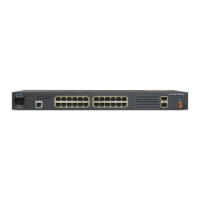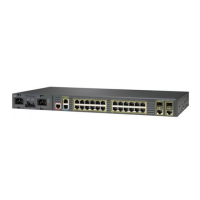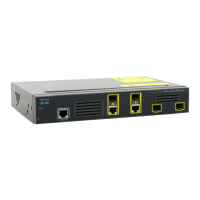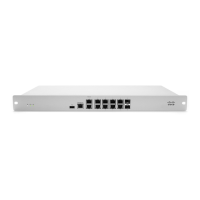34-16
Cisco ME 3400 Ethernet Access Switch Software Configuration Guide
OL-9639-07
Chapter 34 Configuring EtherChannels and Link-State Tracking
Configuring EtherChannels
Step 6
channel-group channel-group-number mode
{auto [non-silent] | desirable [non-silent] | on} |
{active | passive}
Assign the port to a channel group, and specify the PAgP or the
LACP mode.
For channel-group-number, the range is 1 to 48. This number
must be the same as the port-channel-number (logical port)
configured in the
“Creating Port-Channel Logical Interfaces”
section on page 34-14.
Note For UNIs, the only available mode is on.
For mode, select one of these keywords:
• auto—Enables PAgP only if a PAgP device is detected. It
places the port into a passive negotiating state, in which the
port responds to PAgP packets it receives but does not start
PAgP packet negotiation.
• desirable—Unconditionally enables PAgP. It places the port
into an active negotiating state, in which the port starts
negotiations with other ports by sending PAgP packets.
• on—Forces the port to channel without PAgP or LACP. With
the on mode, a usable EtherChannel exists only when a port
group in the on mode is connected to another port group in
the on mode.
• non-silent—(Optional) If your switch is connected to a
partner that is PAgP capable, configure the switch port for
nonsilent operation when the port is in the auto or desirable
mode. If you do not specify non-silent, silent is assumed.
The silent setting is for connections to file servers or packet
analyzers. This setting allows PAgP to operate, to attach the
port to a channel group, and to use the port for transmission.
• active—Enables LACP only if a LACP device is detected. It
places the port into an active negotiating state in which the
port starts negotiations with other ports by sending LACP
packets.
• passive—Enables LACP on the port and places it into a
passive negotiating state in which the port responds to LACP
packets that it receives, but does not start LACP packet
negotiation.
For information on compatible modes for the switch and its
partner, see the
“PAgP Modes” section on page 34-5 and the
“LACP Modes” section on page 34-6.
Step 7
end Return to privileged EXEC mode.
Step 8
show running-config Verify your entries.
Step 9
copy running-config startup-config (Optional) Save your entries in the configuration file.
Command Purpose

